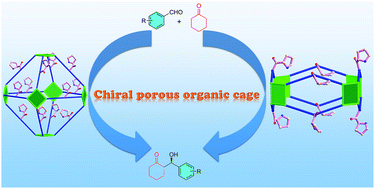Chiral proline-substituted porous organic cages in asymmetric organocatalysis†
Abstract
The efficient preparation of chiral porous organic cages (POCs) with specific functions is challenging, and their application in asymmetric catalysis has not previously been explored. In this work, we have achieved the construction of chiral POCs based on a supramolecular tetraformyl-resorcin[4]arene scaffold with different chiral proline-modified diamine ligands and utilizing dynamic imine chemistry. The incorporation of V-shaped or linear chiral diamines affords the [4 + 8] square prism and [6 + 12] octahedral POCs respectively. The appended chiral proline moieties in such POCs make them highly active supramolecular nanoreactors for asymmetric aldol reactions, delivering up to 92% ee. The spatial distribution of chiral catalytic sites in these two types of POCs greatly affects their catalytic activities and enantioselectivities. This work not only lays a foundation for the asymmetric catalytic application of chiral POCs, but also contributes to our understanding of the catalytic function of biomimetic supramolecular systems.

- This article is part of the themed collection: Most popular 2022 catalysis articles


 Please wait while we load your content...
Please wait while we load your content...